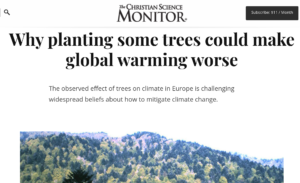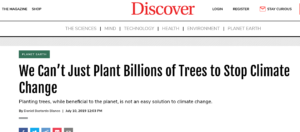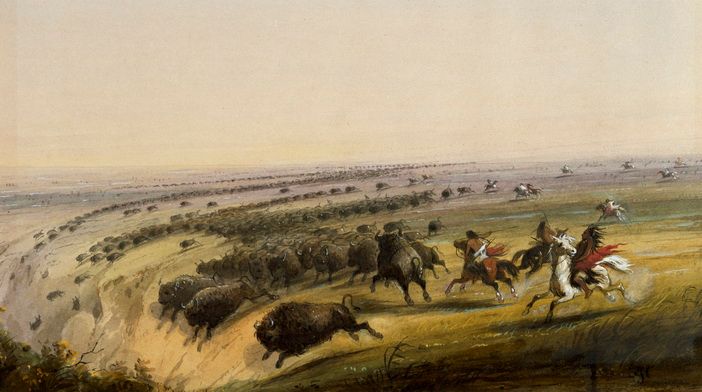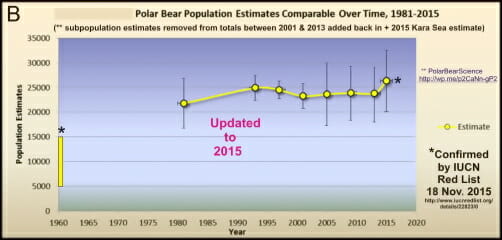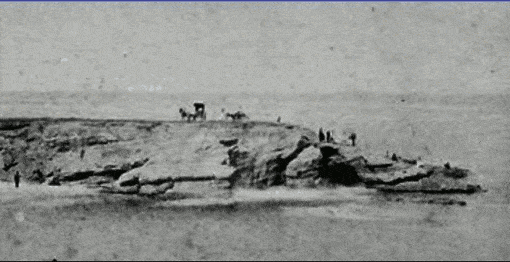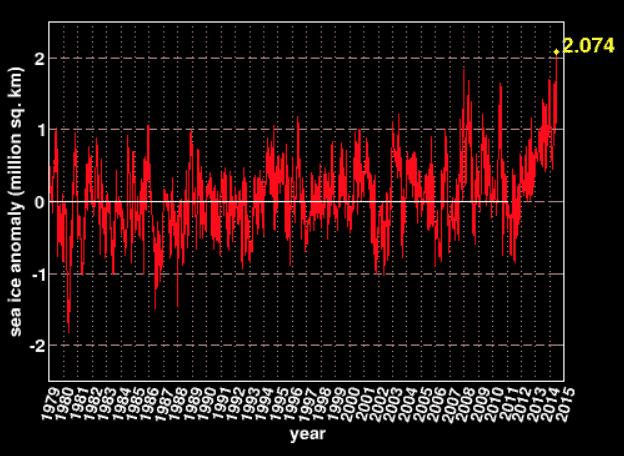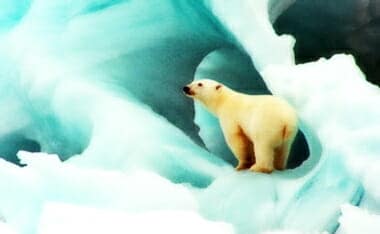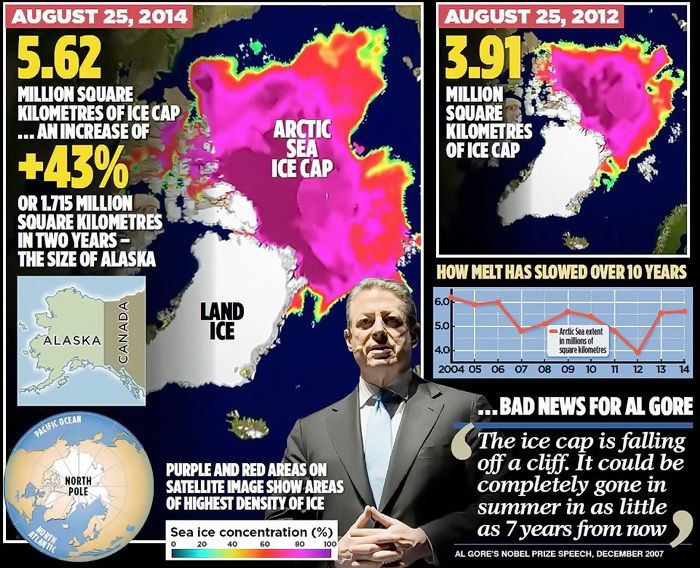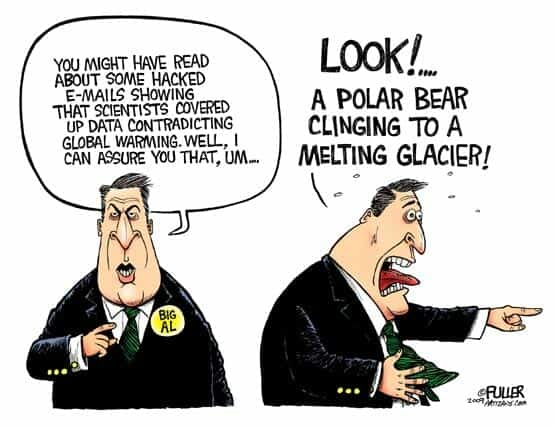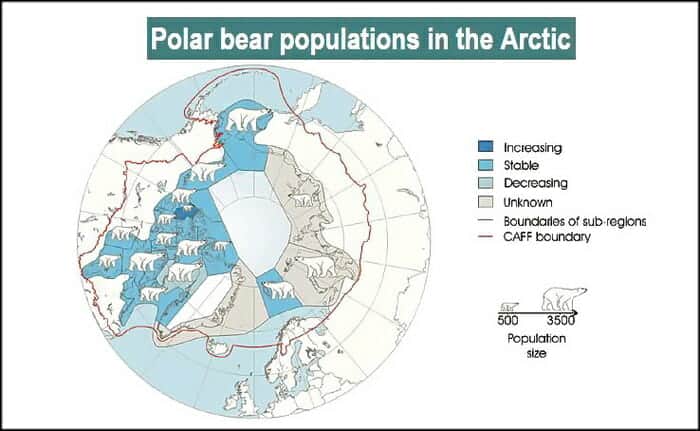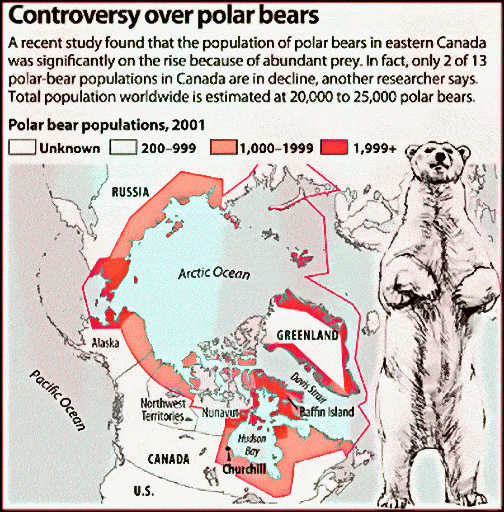(Originally Posted Apr 22, 2015 | New Audios)
I wanted to play the video in whole, then go through 6-points it makes to shed more light on them.
Okay, lets deal with them in order.
- Deforestation [below/left]
- Native-Americans
- Polar Bears
- Sea Level Rise
- China v. Sarah Palin
- Ice Melting
- Rockets
An external point-by-point critique:
(I recently added to this next section)
DEFORESTATION
Prince EA’s mentioning that a future generation of people will not know what trees are is JUST LIKE people telling us kids will not know what snow is like:
Snowfalls are now just a thing of the past
Monday 20 March 2000
Britain’s winter ends tomorrow with further indications of a striking environmental change: snow is starting to disappear from our lives.
Sledges, snowmen, snowballs and the excitement of waking to find that the stuff has settled outside are all a rapidly diminishing part of Britain’s culture, as warmer winters – which scientists are attributing to global climate change – produce not only fewer white Christmases, but fewer white Januaries and Februaries.
[….]
However, the warming is so far manifesting itself more in winters which are less cold than in much hotter summers. According to Dr David Viner, a senior research scientist at the climatic research unit (CRU) of the University of East Anglia,within a few years winter snowfall will become “a very rare and exciting event”.
“Children just aren’t going to know what snow is,” he said.
Funny thing is, some record breaking snow-fall followed in the years after… so much so that kids wished they forgot what it was.
But in all seriousness we are seeing similar dire predictions fail about the deforestation of trees. Keep in mind this is not a polemic proving all stories of deforestation false. I merely wish to bring some balance to the issue. For instance, in the Amazon, well over 95% of deforestation comes from cattle ranching, commercial agriculture, and infrastructure improvements. Less than 5% is from legal and illegal logging. Take note as well that The New York Times makes the point that,
- “…for every acre of rain forest cut down each year, more than 50 acres of new forest are growing in the tropics on land that was once farmed, logged or ravaged by natural disaster.”
I love balance.
William Shatner, Captain Kirk of Star Trek fame, mentioned in a National Geographic video that, “rainforests [are] being cleared at the rate of 20 football fields per minute.” If this were truly the case, the forests would have been completely wiped out years ago. In Prince EA’s video he said 40 football fields! In an interview with Dr. Evaristo Eduardo de Miranda (one of the world’s leading experts on deforestation in the Amazon, is a professor of ecology at the University of Sao Paulo, Brazil’s largest institution of higher learning, and president of ECOFORCE, a private, nonprofit, environmental research/educational institution), he was asked where these numbers come from:
Q. There have been many reports by environmental groups in the U.S. claiming that the Amazon rain forest is being destroyed at a frightening pace. Many conflicting statistics are given concerning the alleged rate of destruction — 4 million hectares per year, 8 million hectares per year, 50,000 acres per day, etc. What are the facts and where are these statistics coming from?
A. A good example of this is the report released at the Earth Summit by the FAO [United Nations Food and Agriculture Organization]. FAO claims that the world tropical deforestation rate is 16.9 million hectares per year. FAO has up to the present been still using their discredited 8 million hectares per year rate for deforestation in Brazil. But when pressed at the summit they conceded to the 2.1 million hectares annually that the INPE, the Brazilian national space agency, has asserted is the real rate. This is an admission that they were inflating the deforestation rate by nearly 300 percent.
But they also said that deforestation for all of South America is 6.9 million hectares annually, which raises an obvious problem. Since Brazil has 70 percent of South America’s tropical forests, it would be incredible to suggest that other countries are deforesting at the levels necessary for the FAO figures to be valid. If you subtract the 2.1 million [Brazilian hectares] from the [FAO’s] 6.9 million, you have 4.8 million hectares being cut down annually in the 30 percent of South American tropical forests outside of Brazil. That is far greater than any data shows.
There is a similar problem with their annual 16.9 million hectares statistic for world deforestation. If you subtract Brazil’s 2.1 million, then you must ask who deforests the other 14.8 million hectares. When they were asked these questions, the FAO could not answer. They could not break the numbers down country by country or show any other means by which they arrived at this figure.
Q. No maps, no satellite photos, no national data ? Where did they conjure up these figures?
A. They were put in a very bad light because they could produce nothing to substantiate these fantastic figures. This is an important example, because if the FAO cannot sustain these numbers, then you can imagine that these eco-groups — the NGOs [Non-Governmental Organizations] — could not either. They always use these big numbers to make sensational news stories, but they never can break the aggregate numbers down to show where they come from, and they never produce maps with alleged areas of deforestation specified so that they can be independently verified.
One comment from the inter-webs noted: “The Amazon is just fine, as the people are moving out of the jungle to the cities and the jungle is raging back quite nicely. It’s in Indonesia and the area that the forests are being cut down for palm oil/biofuel productions.” Yep
In fact, the co-founder and long-time director of Greenpeace, Patrick Moore, said: “All these save-the-forests arguments are based on bad science…. They are quite simply wrong… [Phillip Stott and I] found that the Amazon rainforests is more than 90% intact. We flew over it and met all the environmental authorities. We studied satellite pictures of the entire area.” Phillip Stott, who has 30 years of studying tropical forests under his belt as well as being professor of biogeography at London University mentioned that, “there are now still – despite what humans have done – more rainforests today than there were 12,000 years ago.”
Conventional wisdom is often challenged as well by climatologists and specialists in their field. The NEW YORK TIMES passes along the complexity of an issue most people take for granted:
…Deforestation accounts for about 20 percent of global emissions of carbon dioxide. The assumption is that planting trees and avoiding further deforestation provides a convenient carbon capture and storage facility on the land.
That is the conventional wisdom. But the conventional wisdom is wrong.
[….]
Planting trees and avoiding deforestation do offer unambiguous benefits to biodiversity and many forms of life. But relying on forestry to slow or reverse global warming is another matter entirely.
The science says that spending precious dollars for climate change mitigation on forestry is high-risk: We don’t know that it would cool the planet, and we have good reason to fear it might have precisely the opposite effect. More funding for forestry might seem like a tempting easy win for the world leaders at the United Nations, but it’s a bad bet.
SCIENTIFIC AMERICAN gets a bit more detailed regarding the above. But this is a very complicated issue… especially since chopping down massive forests is being posited as a boon to fight “global warming” – to wit:
…A 2007 study in the Proceedings of the National Academy of Sciences found that global-scale deforestation would result in a net cooling, as the changes in albedo and evaporation would overwhelm the impact of all that carbon being released into the atmosphere. But that doesn’t mean we should go about chopping down every tree we can—on the whole, preserving tropical forests and even adding more trees in the equatorial latitudes will be beneficial for the climate, not to mention the biodiversity that depends on rainforests. But large-scale reforestation or afforestation projects in the north may not be the best idea, as Lee says:
People are debating whether afforestation is a good idea in high latitudes. If you plant trees you sequester carbon, which is a benefit to the climate system. At the same time, if you plant trees you warm the landscape because trees are darker compared to other vegetation types. So they absorb solar radiation.
The study is another reminder of just how devilishly complicated the climate system really is….
(TIME)
Here are some other FLASHBACK articles regarding trees and the varying ideas of their effects on our climate:
Plant or not plant trees to fight “global warming?! It’s all so confusing! This is what the (allegedly) settled science says:
Update: BBC: Climate change: Planting new forests ‘can do more harm than good’
Like I said – challenging conventional wisdom. In reality, what throws many of these studies of deforestation off is the urban heat island effect and rural cold island effect. For more on this see Dr. S. Jeevananda Reddy’s (bio) book/chapter: “Climate Change: Myths & Realities”, 2008 — Chapter 7: Ecological changes.
NATIVE-AMERICANS
The second point I wish to comment on, and it is Prince EA’s mentioning of the Native-Americans. I do not doubt that Prince was taught these things in school. However, like many other issues cornered in the monopoly of the government, balance is needed.
For instance, I wrote a response to an in-class supplement to my sons elementary class lesson [he is now married and lives in Florida] about HOW the Settlers treated the New World versus how the Indians treated it. I made sure each parent got a copy and this engendered a visit to see the principle. Here is a quote from that post:
From James Fenimore Cooper to Dances with Wolves and Disney’s Pocahontas, American Indians have been mythologized as noble beings with a “spiritual, sacred attitude towards land and animals, not a practical utilitarian one.”[16] Small children are taught that the Plains Indians never wasted any part of the buffalo. They grow up certain that the Indians lived as one with nature, and that white European settlers were the rapists who destroyed it.
In The Ecological Indian: Myth and History, Shepard Krech III, an anthropologist at Brown University, strips away the myth to show that American Indians behaved pretty much like everyone else. When times were bad they used the whole buffalo. When times were good, “whole herds” of buffalo might be killed only for their tongues or their fetuses.[17] Although American Indians adapted to their environment and were intimately familiar with it, they had no qualms about shaping it to their needs.
Indians set fires to promote the growth of grasses and make land more productive for the game and plants that they preferred. Sometimes fire was used carefully. Sometimes it was not. Along with the evidence that Indians used fire to improve habitat are abundant descriptions of carelessly started fires that destroyed all plant life and entire buffalo herds.[18]
Nor were American Indians particularly interested in conserving resources for the future. In the East, they practiced slash and burn agriculture. When soils became infertile, wood for fuel was exhausted, and game depleted, whole villages moved.[19] The Cherokee, along with the other Indians who participated in the Southern deerskin trade, helped decimate white-tailed deer populations.[20] Cherokee mythology believed that deer that were killed in a hunt were reanimated.
In all, contemporary accounts suggest that many Indians treated game as an inexhaustible resource. Despite vague hints in the historical records that some Crees may have tried to conserve beaver populations by allocating hunting territories and sparing young animals, Krech concludes that it was “market forces in combination with the Hudchild’s Bay Company policies [which actively promoted conservation]” that “led to the eventual recovery of beaver populations.”[21]
Those who blame European settlers for genocide because they introduced microbes that ravaged native populations might as well call the Mongols genocidal for creating the plague reservoirs that led to the Black Death in Europe.[22] Microbes travel with their hosts. Trade, desired by Indians as well as whites, created the pathways for disease.
[16] Shepard Krech III, The Ecological Indian: Myth and History, W.W. Norton & Company; New York: NY (1999), p. 22.
[17] Ibid., p. 135.
[18] Ibid., p. 119.
[19] Ibid., p. 76.
[20] Ibid., p. 171.
[21] Ibid., p. 188.
[22] For a discussion of the effect of the Mongol invasions and their effect on European epidemiology see, William H. McNeill, Plagues and Peoples, Doubleday; New York, NY (1977).
These little historical facts changes the narrative just a tad, doesn’t it? Like when the Iroquois directed their most furious attacks against the Hurons during the Beaver Wars. One Jesuit missionary wrote, “it is the design of the Iroquois to capture all the Hurons, if it is possible; to put the chiefs and great part of the nation to death, and with the rest to form one nation and one country.” American Indians, alongside the Settlers, accelerated their hunting of the American Bison (Buffalo) that contributed to the near extinction of this plains beast. All in the name of the Mighty Buck! (READ MORE)
POLAR BEAR BREAK
(An UPDATED POST on an old one can be found showing the bottom line is that the current population is at record highs.) While not dealt with well in Prince EA’s video, his presentation shows a computerized Polar Bear[s] walking in the background while intimating extinction or low numbers. Again, he probably learned about this in school, so you cannot really blame him fully. He is the product of indoctrination. However, this just isn’t the case. In fact, there are a record number of Polar Bears. Here Is The Bottom Line:
1) It confirms the global population size I published in May 2015 (20,129-32,558; average 26,344). See the graph below, now amended to reflect this point. If global numbers do decline over the next 35 years, it will be from a high point not previously acknowledged by the IUCN Polar Bear Specialist Group (PBSG).
2) The current population trend is listed as: ? Unknown. [NOT declining – if anyone claims it is, send them here: IUCN Red List U. maritimus]
- For the latest – see: FAILED AMSTRUP POLAR BEAR PREDICTIONS HAVE CLIMATE CHANGE COMMUNITY IN A PANIC
(MS) WINNIPEG, Canada (Globe and Mail 4/2012) The number of bears along the western shore of Hudson Bay, believed to be among the most threatened bear subpopulations, stands at 1,013 and could be even higher, according to the results of an aerial survey released Wednesday by the Government of Nunavut. That’s 66 per cent higher than estimates by other researchers who forecasted the numbers would fall to as low as 610 because of warming temperatures that melt ice faster and ruin bears’ ability to hunt. The Hudson Bay region, which straddles Nunavut and Manitoba, is critical because it’s considered a bellwether for how polar bears are doing elsewhere in the Arctic.
[….]
But many Inuit communities said the researchers were wrong. They said the bear population was increasing and they cited reports from hunters who kept seeing more bears. Mr. Gissing said that encouraged the government to conduct the recent study, which involved 8,000 kilometres of aerial surveying last August along the coast and offshore islands.
Mr. Gissing said he hopes the results lead to more research and a better understanding of polar bears. He said the media in southern Canada has led people to believe polar bears are endangered. “They are not.” He added that there are about 25,000 polar bears across Canada’s Arctic. “That’s likely the highest [population level]there has ever been.”
[Editors note: perhaps to 27,000-32,000?]
Again, this throws a monkey wrench into the narrative, and makes the next proposition trues if the counter proposition can be true:
Look, it is simple:
- Either polar bears are dying because of CO2 emissions via man ~ hence, we should stopproducing high levels of CO2;
or [following the train of thinking FROM Al Gore],
- Polar bears are at their highest recorded population levels because of CO2 emissions via man, hence, we should produce high levels of CO2.
If “a,” why not “b”?
Truth About Stranded Polar Bears Image
(SEE MORE)
FOX NEWS & SEA LEVEL RISE
Want to move on quick over this section? Here is my response to a Starbucks patron (of which I count myself) when they bring up sea rise:
- “I believe in sea rise? Hell, 10,000 years ago it was 350ft lower. That is how the American Indian populated the continent.”
Mic Drop!
This was interesting because he calls out a news network. Good for him! He is wrong, but I like his style. This section I will deal with sea level rise in general, and then deal with the Bangladesh portion of Prince EA’s claims. The general sea rise refutation of the school-house session can be seen here, but let us look at a graph:

I wanted to draw the people who believe this (rising oceans) attention to a very old photograph compared to a new one to compare La Jolla (California) sea levels from 1871 to Now (REAL CLIMATE SCIENCE):
Also, Photographs show no change in Sydney sea level over the last 130 years (REAL CLIMATE SCIENCE):
But what interested me was his mentioning Bangladesh specifically… wrapped up in a challenge to Fox News.
Woa Whoa! Throwin’ down the gauntlet. I am going to answer this from various sources, but as you will see, this is another fail on the eco-fascists side. Here is a conservative source first:
It’s hard to believe that it’s been more than a month since the latest example of intellectual collapse at the IPCC. Now added to the fraudulent claims about Amazon rain forests, African crop harvests, and Himalayan glaciers comes the exposure of a very large error in the UN body’s warnings about flooding in Bangladesh. Turns out that the scientists screeching about the cataclysmic effects of sea-level rises forgot to consider sedimentary deposits (via Yid with Lid):
Scientists in Bangladesh posed a fresh challenge to the UN’s top climate change panel Thursday, saying its doomsday forecasts for the country in the body’s landmark 2007 report were overblown.
The Intergovernmental Panel on Climate Change (IPCC), already under fire for errors in the 2007 report, had said a one-metre (three-foot) rise in sea levels would flood 17 percent of Bangladesh and create 20 million refugees by 2050.
The claim helped create a widespread consensus that the low-lying country was on the “front line” of climate change, but a new study argues the IPCC ignored the role sediment plays in countering sea level rises. …
But IPCC’s prediction did not take into account the one billion tonnes of sediment carried by Himalayan rivers into Bangladesh every year, which are crucial in countering rises in sea levels, the study funded by the Asian Development Bank said.
“Sediments have been shaping Bangladesh’s coast for thousands of years,” said Maminul Haque Sarker, director of the Dhaka-based Center for Environment and Geographic Information Services (CEGIS), who led research for the study.
Even if the sea level rises that far — a claim which is itself greeted with increasing skepticism — most of the coastline for Bangladesh won’t be affected.
WHAT’S UP WITH THAT calls this Bangladesh “THE POSTER CHILD,” and here is the end of their report:
Deltas are formed at the boundary of rivers and oceans. The rivers that build deltas flow to low and slowly sinking parts of the crust, where large volumes of sediment are being deposited. They will always be in balance with sea level but almost by definition increase in size, if rivers are allowed to follow their course. Deltas, by their very nature are building out and up. They also tend to flood frequently and seasonally, often with disastrous effects on the inhabitants. People living in deltas should learn to swim, have a boat and generally be aware of what can happen. Sea level rise is not an issue in large deltas; they have been proven to be able to keep up with any sea level rise. Flooding disasters are seasonally the result of excessive run-off, and occasionally due to unfortunate storm surges that result in breaks through natural barriers, but this has nothing to do with sea level rise. Bangladesh will be there, even if all the ice in the world has melted, with its people still fighting floods while farming the fertile floodplains.
Scientific American also takes a wholly different course and shows that current flooding is caused in big part to the Bangladeshi’s themselves:
Man-made flood protections, not climate change, are the main culprit in sea-level rise in southwest Bangladesh, according to new research conducted for the U.S. Navy’s Office of Naval Research.
The report from a team of scientists at Vanderbilt University is the first part in a wide-ranging, $7.5 million analysis of environmental stress and human migration scenarios in the low-lying South Asian nation.
Published this week in Nature Climate Change, the initial study finds that embankments constructed since the 1960s are primarily to blame for lower land elevations along the Ganges-Brahmaputra River Delta, with some areas experiencing more than twice the rate of the most worrisome sea-level rise projections from the United Nations’ Intergovernmental Panel on Climate Change.
OF COURSE the magazine then goes on to assert Climate Disruption is still a threat to Bangladesh (towing the line is tough!). But this problem is moot because they gain land from the delta and the flooding is mainly “man-made,” so are the solutions [technology].
CHINA vs SARAH PALIN
WOW, another challenge. Good for you Prince EA! But again, your understanding is wrong.
The Atlantic Monthly has a VERY interesting article I read a few years back. They note that in reality the pollution in China is at our 1980-levels.
Does China, in short, truly deserve its reputation as an environmental pariah?
Ramon Guardans, a biologist who studies air pollution and co-chairs a global monitoring plan on toxic chemicals for the United Nations Environment Program, is skeptical.
“The air concentrations of several pollutants in sites in China are certainly comparable to the levels observed in heavily industrialized areas in Europe and North America before the 1970’s,” he wrote by email. But pound for pound, person for person these pollutant emissions were, and generally still are, much greater than China’s.
“So in relation to the population density we see in China,” Guardans continues, “the U.S. and Europe did a much dirtier job industrializing.”
Beijing just happens to be, similar to Los Angeles, in a geographical bind. Bloomberg makes this point as well around the same time the Atlantic Monthly does:
Why is Beijing susceptible to these episodes? First, and uncontrollable by the authorities, are the peculiarities of Beijing’s geography. In particular, the capital is surrounded by mountain ranges that lead to the unfortunate phenomenon of an inversion layer—cold air settles on top of a warmer air mass, trapping the pollutants inside. This is the same problem that bedevils Los Angeles.
Beyond the misfortune of geography, though, lie a number of factors that have everything to do with China’s policies….
China is blessed and cursed with the world’s largest coal reserves, which means that the country sources some 80 percent of its electricity from burning coal—and much of that coal is of lower quality and highly polluting.
But as I have clearly shown… wind and solar energy is no cleaner. And the dream in peoples heads is truly just that, a dream… I mean when Google caves, you know the end-is-nigh.
- “Even if one were to electrify all of transport, industry, heating and so on, so much renewable generation and balancing/storage equipment would be needed to power it that astronomical new requirements for steel, concrete, copper, glass, carbon fibre, neodymium, shipping and haulage etc etc would appear. All these things are made using mammoth amounts of energy: far from achieving massive energy savings, which most plans for a renewables future rely on implicitly, we would wind up needing far more energy, which would mean even more vast renewables farms – and even more materials and energy to make and maintain them and so on. The scale of the building would be like nothing ever attempted by the human race.”
I must say I’m personally surprised at the conclusion of this study. I genuinely thought that we were maybe a few solar innovations and battery technology breakthroughs away from truly viable solar power. But if this study is to be believed, solar and other renewables will never in the foreseeable future deliver meaningful amounts of energy.
And bio-fuels cause, literally, food riots and starvation in poor countries and raise the price of food which hurt the poorer people in the more well off nations: Ethanol is killing children around the world… Democrats! It takes 450lbs of Corn to fill one SUV tank… that is a years worth of food for multiple children, not to mention the rise of corn-based food for the poor worldwide. (SEE MORE)
ICE MELTING
Here is another fail on the part of the doomsayers who speak with a tongue very similar to the eschatology handed us at the most fiery southern Baptist church.
Prince EA is just relying on others work that have been either proven wrong or fraudulant in nature. Here for instance we see some predictions simlar to Prince’s:
“Peter Wadhams, who heads the Polar Ocean Physics Group at the University of Cambridge… believes that the Arctic is likely to become ice-free before 2020 and possibly as early as 2015,” (YALE ENVIRONMENT 360 REPORTED IN 2012). Yet government data shows that arctic sea ice has increased since then….
Here I will post information from a PREVIOUS POST about Polar Bear population levels, in which I point the following out:
Recent Population Increase Partly Due To Lots of Sea-Ice
Canada (CBC News via the Canadian Coast Guard, 3/2014) [ARCTIC Sea Ice] The Canadian Coast Guard is pleading with merchant ships to plan their voyages well in advance this year as the organization’s icebreaker fleet confronts some of the worst ice conditions on the Atlantic Ocean in decades.
“Plan your voyage and we’ll all get through this,” said Mike Voight, the Atlantic region’s director of programs. “We’ve got a pretty bad or challenging ice year.”
The Canadian Ice Service, an arm of Environment Canada, said there is 10 per cent more ice this year compared to the 30-year average.
“We probably haven’t seen a winter this bad as far as ice for the past 25 years,” said Voight, referring to both the amount and thickness of the ice….
The American Geophysical Union (AGU) Abstract (12/2014) [ARCTIC sea ice] Despite a well-documented ~40% decline in summer Arctic sea ice extent since the late 1970’s, it has been difficult to estimate trends in sea ice volume because thickness observations have been spatially incomplete and temporally sporadic. While numerical models suggest that the decline in extent has been accompanied by a reduction in volume, there is considerable disagreement over the rate at which this has occurred. We present the first complete assessment of trends in northern hemisphere sea ice thickness and volume using 4 years of measurements from CryoSat-2. Between autumn 2010 and spring 2013, there was a 14% and 5% reduction in autumn and spring Arctic sea ice volume, respectively, in keeping with the long-term decline in extent. However, since then there has been a marked 41% and 9% recovery in autumn and spring sea ice volume, respectively, more than offsetting losses of the previous three years. The recovery was driven by the retention of thick ice around north Greenland and Canada during summer 2013 which, in turn, was associated with a 6% drop in the number of days on which melting occurred – climatic conditions more typical of the early 1990’s. Such a sharp increase in volume after just one cool summer indicates that the Arctic sea ice pack may be more resilient than has been previously considered.
Talking About Weather (7/2014) [ANTARCTIC sea ice] Antarctic sea ice has hit its second all-time record maximum this week. The new record is 2.112 million square kilometers above normal. Until the weekend just past, the previous record had been 1.840 million square kilometers above normal, a mark hit on December 20, 2007, as I reported here, and also covered in my book.
Mark Serreze, director of the National Snow and Ice Data Center, responded to e-mail questions and also spoke by telephone about the new record sea ice growth in the Southern Hemisphere, indicating that, somewhat counter-intuitively, the sea ice growth was specifically due to global warming.
Let us compare this to Al Gore saying the northern ice-caps will be gone
NewsBusters makes the point another way, in that the “media” is derelict in their duty:
The same year that former Vice President Al Gore predicted that the Arctic sea ice could be completely gone, Arctic ice reached its highest level in two years, according to a report by theDanish Meteorological Institute.
According to that report, which was cited by the Daily Mail (UK) on Aug. 30, “[t]he Arctic ice cap has expanded for the second year in a row.” The U.S. National Snow and Ice Data Center (NSIDC)confirmed this trend, but didn’t go into as much detail as the Danish Meteorological Institute.
But an examination of ABC, CBS and NBC news programs since the Daily Mail story was published found that all three networks ignored news that Arctic sea ice was at a two-year high….
Remember, you can lead a horse to water but cannot make it drink.…read it all at Fox News.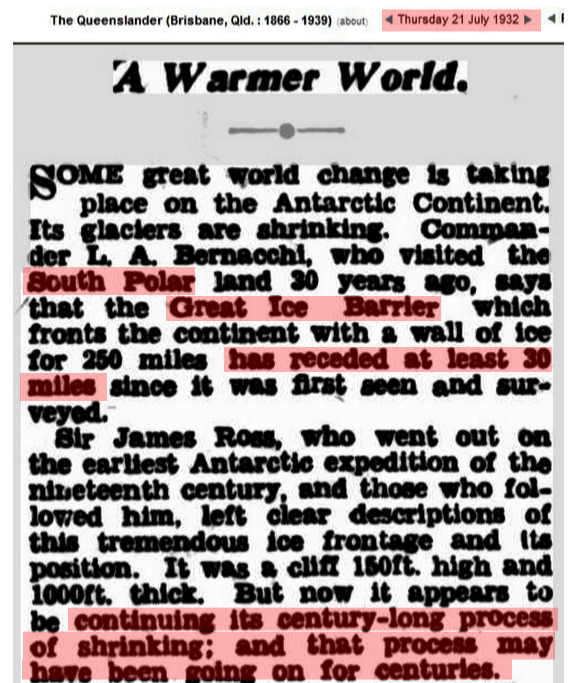
“The West Antarctic ice sheet sits on bedrock which is below sea level. It formed during the ice age but the sea level rose 12,000 years ago and has been chipping away at it ever since. What happens to ice which sits on rock which is below sea level? Hint: it has nothing to do with CO2.” This is a comment from Real Science’s FLASHBACK to 1932 and how the ICe-Sheets were melting then (to the right).
AND FINALLY….
ROCKETS
I hate to break it to Prince EA, but that rocket to find other worlds would have to be powered by (in part) fossil fuels to break earths gravitational force. Not to mention the massive amount of energy (fossil fuels again) And often times the left kills innovation in areas (like nuclear) for ideological reasons. Keeping us dependent on fossil fuels.
You see, all of the above “sounds good,” and grand. But as Thomas Sowell says, liberals — unlike conservatives — do not ask three simple questions:
- compared to what?
- at what cost?
- what hard-evidence do you have?
FOR INSTANCE, as an example, Google came to the logical conclusion that such endeavors with alternative fuels is unattainable:
We came to the conclusion that even if Google and others had led the way toward a wholesale adoption of renewable energy, that switch would not have resulted in significant reductions of carbon dioxide emissions. Trying to combat climate change exclusively with today’s renewable energy technologies simply won’t work; we need a fundamentally different approach.
[….]
“Even if one were to electrify all of transport, industry, heating and so on, so much renewable generation and balancing/storage equipment would be needed to power it that astronomical new requirements for steel, concrete, copper, glass, carbon fibre, neodymium, shipping and haulage etc etc would appear. All these things are made using mammoth amounts of energy: far from achieving massive energy savings, which most plans for a renewables future rely on implicitly, we would wind up needing far more energy, which would mean even more vast renewables farms – and even more materials and energy to make and maintain them and so on. The scale of the building would be like nothing ever attempted by the human race.”
Google Joins the Common Sense Crew On Renewable Energies ~ Finally! (RPT)
- What It Would Really Take to Reverse Climate Change (SPETRUM)
- Shocker: Top Google Engineers Say Renewable Energy ‘Simply won’t work’ (WATTS UP WITH THAT)
- Polluting the Beauty and Cleanliness Of Our World With Renewable Energy (RPT)
- Wind and Solar More Harmful To Environment Than Helpful (RPT)


